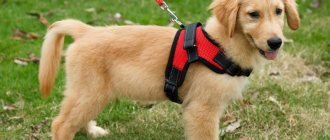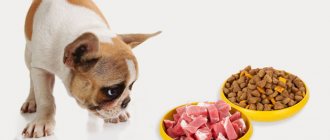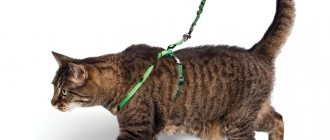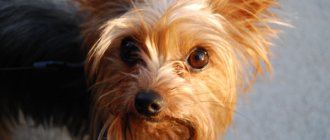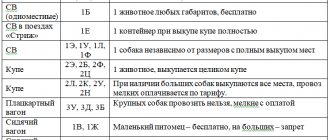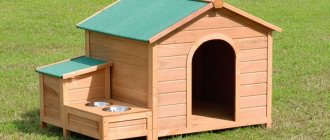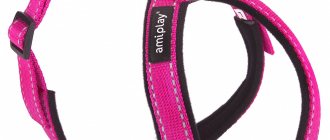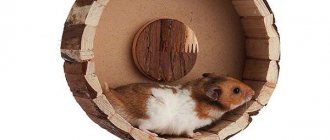Collars, leashes and harnesses are necessary items for those who have a dog in the house. It doesn’t matter at all what size, breed, weight it is, it’s impossible to even imagine a walk without them. A harness is considered less traumatic than a collar. It is securely fixed on the shoulders and chest. To prevent this harness from causing discomfort to your pet, you need to know how to put a harness on a dog - step by step instructions will be in the article.
Both harnesses and collars have probably been used as long as dogs have been living side by side with humans. Initially, harnesses were used to harness sled dogs. For transporting goods and people, a regular collar was inconvenient. It puts too much pressure on the animal's neck and often causes injury.
The harness has no such drawback. It allows you to evenly distribute a large load, without harm to the dog’s health. This accessory is still used today. It is popular with owners of small dogs and for overly active pets. It is not easy to keep animals on a collar while walking. With sudden movements, the dog simply hangs on the collar, which often leads to serious injury and even more tragic consequences.
What is a harness
A harness is a device consisting of belts, metal rings and fasteners that is used to control a dog's behavior. A leash is additionally attached to it.
The straps are positioned so as to wrap around the dog's chest, and sometimes around the croup. The main strap runs between the animal's front legs and is attached to the chest and circumference straps. The clasp is located in the withers area. There are also two rings attached for a leash, which is fastened with a special carabiner.
In this case, the main thing is that the dog’s neck remains free. Therefore, first of all, a harness is put on a dog whose neck has been damaged in some way - there has been surgery, there are tumors or wounds.
Sometimes it is easier for an animal owner to handle his dog with the help of a harness. After all, some pets manage to wriggle out of the collar and thus free themselves from the control of the owner.
Harnesses are worn by service dogs that are trained to rescue people. This accessory is necessary for sled dogs. During sports and strength training to develop muscles and various necessary skills, pets also wear them.
Materials and tools for making a dog collar
How to make a collar for your beloved dog with your own hands at home? First of all, you need to acquire the necessary tools and decide on the materials from which the collar will be made.
Nylon Ribbon Collar
A collar made from nylon tape is very easy to make. To do this you will need:
- nylon tape;
- textile tape or neoprene strip;
- plastic carabiner;
- buckle with two holes;
- ring in the shape of the Latin letter D;
- sewing machine.
Algorithm of actions:
- The first step is to measure the volume of your pet's neck. The result obtained should be multiplied by 1.7.
- Cut the nylon and textile tape to the required length.
- Using a sewing machine, sew both ribbons into one. The stitching should be done in such a way that the line being laid is as close to the edge as possible.
- The next step is to attach the plastic carabiner. To do this, you need to pull about 4 cm of tape through the carabiner and secure it with machine stitching as close as possible to the plastic jumper.
- Next, you need to insert the D-ring and finally secure the piece of tape.
- The free end must be pulled through the second part of the carabiner.
- To adjust the volume of the collar, you need to use a mobile buckle with two holes. To do this, you need to push the tape through the holes and securely secure it with double or triple stitching.
It’s not at all difficult to make a leash from nylon tape with your own hands.
Leather collar
As practice shows, a leather collar is the most practical option for a dog accessory. To make it you will need:
- leather belt;
- buckle with rod;
- ring in the shape of the Latin letter D;
- rivets;
- special glue for leather.
The algorithm of actions is as follows:
- First you need to measure the volume of the dog's neck. To the resulting figure you need to add 24 cm.
- You need to cut a piece from the belt equal to the result obtained during measurement.
- Next, you should round off the ends and treat the edges of the belt with leather glue. This must be done to ensure that the future product does not rub the pet’s skin.
- The next step is to mark the rivets and holes for the buckle shank. Once the markings are applied, you need to make holes with an awl. To make your work easier, the awl can be heated.
- The last step is to install the buckle. To do this, you need to thread the edge of the belt through it and secure it with rivets.
A paracord collar can highlight your pet’s individuality
Paracord collar
Paracord is a cord that is commonly used to make parachute lines. In addition to its direct purpose, it is widely used for a wide variety of purposes. You can try making a braided collar for your dog from it. You should have on hand:
- paracord rope;
- ring in the shape of the Latin letter D;
- fastex - carabiner for fastening;
- lighter;
- stick for pushing the cord.
Step-by-step master class:
- The work begins with measuring the dog's neck. The result should be multiplied by 3. The resulting figure will indicate the length of the cord that will be required to make a braided collar.
- Cut the cord into 3 parts. The ends of the cut cord must be scorched with a lighter to avoid destruction of the structure.
- The clasp of the future collar should be unfastened and the cords should be secured so that the outer ones are several centimeters longer than the one in the middle.
- Next, weaving is done using the macrame technique.
- Having reached the end, you need to weave a D-ring to attach the leash.
- The last stage is securing the cords to the second part of the fastex. To prevent the ends of the cords from sticking out, they should be soldered to the inside of the collar using a lighter.
A collar is an accessory on which not only the pet’s cute appearance, but also its safety depends. Whether purchased at a pet store or homemade, it must fully meet this main criterion.
Harness or collar?
A collar is a very convenient accessory because it can be used to easily control a dog , especially a large breed. It is much easier to correct behavior by gently tugging on the leash when it is only attached to the dog's neck. The dog feels any movement of the leash much better in such a situation.
When a dog is wearing a harness, the load on the owner's hand increases significantly. Because in this case, the animal acts with its entire body, pulling the person behind it with much greater force. In addition, the pet does not feel the movement of the leash so much, so it will react worse to the owner’s attempts to calm it down.
The harness forces the dog to keep its neck parallel to the ground. In some breeds, for example, Jack Russell terriers, this provokes an incorrect neck position and an uneven distribution of the overall load on the dog’s body. This is fraught with further problems with the spine.
In some dogs, the elbows of the front legs are not pressed very close to the body. Wearing a harness in such a situation will make the situation even worse. This can lead to incorrect position of the paws, which can lead to problems with appearance and gait. And in the future, to some diseases of the musculoskeletal system.
The collar also has its drawbacks . The dog's neck is the most vulnerable place. Any discomfort in this place is perceived by the animal as a threat to life. Accordingly, the reaction to a strong tug on the leash attached to the collar can be very aggressive.
As a result of observations, it became known that most spinal diseases in dogs are the result of constantly wearing a collar. Strong tugging on the leash can lead to vision and hearing problems. The nervous system also suffers, because pressure in the throat area is a serious stress.
So, the best thing is to alternate wearing a harness and a collar in different situations . It all depends on the breed, size of the dog, its character and the capabilities of the owner.
As for dogs of different breeds, there are some nuances here. For example, short-necked breeds such as the French Bulldog and Pekingese will prefer to wear a harness.
For dogs of small breeds - Chihuahuas, Yorkies, Spitz, Toy Terriers, lapdogs, a harness is also better suited. Because these babies have a rather delicate skeletal system, a thin neck, which is very easy to damage.
Large breeds such as Labrador or German Shepherd will do well to be trained to wear both a harness and a leash.
The main thing is to teach the dog discipline, especially on the street. This applies to both large and small breeds. Because, knowing the command “near”, the dog will never provoke a situation that is traumatic for itself and the people around it.
Unrecognized
Breeds not recognized by the FCI include:
- Norwegian sports mestizos;
- Eskimo husky;
- wolf-dog;
- Sakhalin Husky;
- Chinook.
Norwegian sporting crossbreeds
Norwegian mixed breed
Norwegian mestizos are the fruit of the painstaking work of the hands of breeders who carried out matings between:
- greyhounds;
- kurtshaars;
- pointers.
The dog was created specifically to participate in sports competitions and has good physical characteristics combined with a gentle disposition.
Buying such a puppy is not easy. Due to the lack of official confirmation, it is difficult to confirm the quality of the animal being purchased.
Eskimo Husky
Eskimo Husky
North American native dog of medium size. The animal is not suitable for families with small children and needs access to constant work.
The Laika is quiet, friendly, hardworking and has hunting skills. The fearless animal was used to hunt polar bears.
The pet is not suitable for keeping in warm climates and is susceptible to sunstroke.
Due to their rarity (there are no more than 5 hundred officially registered animals), the cost of puppies reaches 420 thousand rubles.
Wolfdog
Wolfdog
Wolfdogs are unique hybrids obtained by crossing wild wolves and German shepherds. The attractive appearance inherited from the wolf and the character inherited from the shepherd allowed the animal to be used in dog sledding and service work.
It will not be possible to purchase such a pet, since sales are prohibited. The breeding project and the results obtained belong to Russian scientists.
Sakhalin Husky
Sakhalin Husky
The result of crossing Akita Inu and Spitz from Japan. Animals are fearless, prone to dominance and strongly attached to their owners.
With prolonged loneliness, Sakhalin residents develop severe psychological problems leading to physical illnesses. Prices for puppies start from 20 thousand and reach 50 thousand rubles.
Sakhalin Huskies are not suitable for apartment living and will throw a real concert after the owner leaves for work. At the same time, they perceive the harsh conditions of the Far North with ease, enjoying participation in human expeditions.
Types and types of harnesses
Depending on their purpose, harnesses come in the following types:
A harness for walking is a common accessory that is sometimes used every day when going outside with a dog. Its lock is located in the dog’s withers, as are the rings for attaching the leash. You can purchase such a harness at any pet store or even sew it yourself. They come in different sizes, both for very small dogs and puppies, and large breeds.
Harness-vest – it is used for small dogs. It fastens in front or on the sides. On the back, near the withers, a ring is sewn onto a strong synthetic tape for attaching a leash. Such vests are made for the cold season from durable and warm material with a lining. They protect the dog's lungs from colds. Summer vest harnesses are made of mesh material so that air can easily pass through. This accessory is especially convenient for pets of small breeds, since the soft material does not compress the chest and armpit area, and does not rub the skin. In one of the articles on our website you will find detailed instructions on how to sew a harness for a dog with your own hands, a master class with patterns.
How to accustom an animal to a harness
Most often, problems with taming to a harness do not arise. As in other similar cases, a treat will be required.
The first time you need to let the baby get acquainted with the product. You shouldn't let him play with the ammunition. You need to move on to the next stage only when the puppy has become accustomed to the product and becomes indifferent to it.
The fastest way to get used to it is on the street. This is due to the fact that the puppy is fascinated by the world around him and will pay less attention to the equipment. You can remove the harness only after the baby gets used to it.
Important! It is necessary to ensure that the product does not create discomfort. Then the pet will get used to it faster and easier.
Accustoming usually takes only a few days, after which the procedure for putting on equipment will not cause problems.
A good combination of price and quality include products Collar, Trixie, Coastal
From what age
The puppy has a rather fragile skeletal system, his muscles are not fully formed, he is growing and changing. Therefore, any improper load can cause irreparable damage. The limbs and chest will not form correctly.
Therefore, it is best to put a harness on a small breed dog for the first time at the age of 6 months. For large breeds this age ranges from 8 to 10 months. In this case, you will need to consult with a specialist to choose the appropriate ammunition.
For puppies, there are special harnesses made of soft, elastic materials and thin straps. They have fewer metal parts, are lightweight and at the same time durable.
Correct selection
To ensure that the harness does not harm your pet, it is necessary to choose it correctly. Major manufacturers of pet accessories have special tables that take into account dog sizes, weights and volumes. Some brands make adjustments based on breed.
To choose the right harness, you will need the following measurements:
- The dog's height is measured in a standing position from the withers to the floor.
- The length of the back is equal to the distance from the tail to the base of the neck.
- The chest is measured along the front surface from the right front paw to the left. The centimeter should not be too tight so that the harness does not restrict freedom of movement.
- The size of the neck is measured at the base, it is in this area that the top strap of the harness is located.
- The length from chest to withers is measured for sled dogs.
- Therapeutic harness is made individually, taking measurements and leaving 2 cm for freedom of fit. For small dogs, the allowance is smaller.
When purchasing a harness, it is checked for comfort. To do this, after putting the accessory on the dog, insert your palm under any of the belts. If the hand moves freely and the device does not dangle, then the size is chosen correctly.
The accessory is also used for cats; the method of habituation for them is similar to that described above using the example of dogs.
How to choose the size
Size is very important, since a tight harness can cause various diseases and deformities of the paws. It will be difficult to hold a pet in too loose ammunition, since he can easily “wriggle out” of it.
An incorrect size will result in the sternum strap being too close to the armpit. And this is serious discomfort for the pet. The dog will try to avoid it by twisting its elbows. If you wear such a problematic harness all the time, then incorrect paw placement and gait are guaranteed. This is especially important for animals that are planned to be taken to exhibitions.
How to choose the right product
How to properly punish a dog for disobedience
A dog leash must be selected based on several different criteria. The first thing you should pay attention to is the size. A product that is too tight can lead to the development of various diseases or deformities of the paws. Too loose ammunition can cause the pet to break out.
Sizing
The wrong size makes it difficult to fasten the harness, it begins to move, and the chest strap ends up too close to the armpit. This situation causes severe discomfort. Over time, the dog will constantly struggle and twist, and will develop an abnormal gait.
There is a direct correlation between leash tugging and back problems.
Before heading to a specialty store, you need to take your dog's measurements. Measurements should be taken in this order:
- Neck circumference. The measurement is taken in the area where the collar is usually worn.
- Chest circumference. This indicator is determined behind the elbows in front of the paws, a little further from the armpits. If the dog is small, you need to add one centimeter. It will be easier for your pet to wear such a harness.
- Back length. It is measured from the withers to the base of the tail.
An important indicator is weight. Some products are not designed for the heavy load that will be exerted by large individuals. It should be taken into account that after purchasing a leash for a puppy, you will have to buy a new product in the near future, since the pet grows very quickly.
Material selection
The next selection criterion is the type of material used in manufacturing. The most commonly used material is canvas fabric, which is cheap but wears out quickly. If the structure gets wet quickly, it takes a long time to dry.
Another common choice is natural or artificial leather. Such material wears out quickly in extreme situations, so it is used for making exhibition harnesses. It is also worth considering that puppies love to chew on such material.
Nylon or nylon is considered to be a universal material. Basic properties:
- practically does not get wet;
- the surface is easy to clean at any time;
- nylon does not burst, does not become rough over time, and keeps its shape.
- The resulting seams are strong and tear very rarely.
The only serious disadvantage of artificial materials is that artificial materials cause an allergic reaction. Such a reaction occurs extremely rarely.
The harness is ideal for active animals and sledding breeds
Types of fasteners and belts
Another selection criterion is the number of fasteners and straps. A small animal requires a product with only a few straps. The relatively small load that is placed on the harness determines the use of plastic fasteners. They are inexpensive and durable.
Problems may arise when the product has only a few fasteners and the dog is heavy. They can be pressed into the fur.
For large dogs, you need to purchase a product with metal fasteners. The number of belts is selected depending on the task at hand. For a regular walk, only 3 harnesses are enough; for a sled dog, an option with 5-8 elements is required. They must run along the entire length of the body and are attached to the edges with special carabiners.
The design of the harness depends on the purpose
As the number of rings increases, the leash will hold stronger. If the pet often rushes forward, has a playful disposition and a large mass, then an option with three or more rings will be required.
Important! It is not recommended to take options with a large number of fasteners. This is due to the fact that the dressing procedure can take a long time.
For a small dog
Small breeds - Chihuahuas, toy terriers, Yorkies, dwarf dachshunds, Spitz dogs, lapdogs and other children - are suitable for mini-harnesses with thin, silky, but quite durable straps. Such accessories are practically no different in their configuration from those intended for large dogs. They are simply smaller in size, have bright colors and are made from more delicate materials.
However, such ammunition will be durable and the dog will not jump out of it. In addition to harnesses, and especially harnesses-vests for small breeds, a special handle can be sewn on the back. This is done so that in a dangerous situation you can easily pick up the pet in your arms or, say, carry it through a puddle that is too large.
Knitted clothes
If you are not comfortable with a needle and thread, but are great with knitting needles, then we hasten to please you - knitted clothes for dachshunds are easy to make and practical, just like those made from fabric. For this work, 200 g of any yarn of medium thickness will be useful: perhaps you have a ball lying around from a previously knitted scarf or sweater, or you purchased a warm woolen thread especially for this case. Here are some tips for creating a stylish sweater:
Start knitting it from the neck.
- On the back side, reduce the number of stitches to avoid the formation of folds and wrinkles.
- The sleeve knitting technique is similar to the technique for the fingers of gloves.
- Decorate the finished sweater with decor or add buttons.
The variety of yarn colors allows you to create not only clothes that are comfortable for your dachshund, but also a whole work of design art.
Advanced knitters can afford to give their pet a whole costume: a warm blanket or sweater and boots in case of particularly severe frosts. An evening of work will be fully repaid with doggy joy.
For a big dog
Large animals need accessories that can withstand serious loads - heavy weight and jerking force. Therefore, we can recommend a leather model here. The metal parts must also be powerful and cast. You can’t save money here and buy something simple. Because the power of the animal is capable of bending even metal parts and breaking belts. As a result, at an inopportune or dangerous moment, the dog’s leash will fly off and the harness will fall apart. The consequences will be unpredictable.
For large individuals with a calm character, models of the same design as for small dogs are suitable. If the animal shows aggression or is a service animal, then a more durable model is needed, consisting of two circular belts covering the chest and croup, connected at the bottom between the paws and along the back with separate slings.
The leash is also attached to the withers.
What to do if your pet resists?
As a rule, dogs are afraid of everything new and unfamiliar. In the case of a harness, you shouldn’t expect your pet to stand “at attention” and endure it. Most likely, he will try to break free and get rid of the unknown object.
It is quite possible that it will take some time to get to know the harness. You need to introduce the dog to her. That is, let her sniff and show that the object is not dangerous for her. During the fitting process, act calmly but persistently. Encouraging him at the right moments with treats and petting.
If the dog growls and breaks out, punish and stop. You need to be able to insist on your own.
Quality, quantity of fasteners and straps
When choosing an accessory, you need to pay attention first of all to the fittings. Plastic fasteners are suitable for a small dog. For large and well-fed individuals, exceptionally powerful fittings are required, preferably metal ones. Be sure to check the fittings for strength, pay attention to the fact that the rings are cast, solid, made of steel.
The more fasteners and fastenings, the stronger the harness. All parts should fit well together, snap easily and not unfasten when pulled. All belts must be adjustable in length.
An important point - all belts must be stitched and not glued together!
When trying on, check how the straps are positioned, whether they press, do not rub, do not interfere with the dog’s movement, and do not dig into the armpits.
Harness for transporting dogs in the car
All pets behave differently when traveling: some sleep, while others fight the seats and try to escape. It will be optimal for restless dogs, as it has a special fastening that helps to fasten the pet and limit its movements around the car. Such ammunition is attached to special belts (included in the kit), which are passed through the upper handles in the car.
Thanks to the wide range, you can choose for any pet. Currently, 10 variants of such accessories have been developed, thanks to which you can choose it for a dog of any size.
Material
The cheapest harnesses are made from canvas. This is a good material, but it wears out quickly and takes too long to dry when wet.
TEST.TV: Harness or collar?
Leather always looks beautiful, even if it is artificial. However, in extreme situations this material wears out quickly. In water, the skin stretches, in cold or heat it quickly cracks. So accessories made from this material are preferable for exhibitions and various kinds of exhibition events, city walks in good weather. Keep in mind that dogs love to chew leather straps.
Universal material is nylon, nylon. It practically does not get wet, it can always be cleaned. It does not burst, does not become rough over time, and holds its shape well. The seams on nylon are always strong and tear extremely rarely. In general, the material is able to withstand enormous loads for years.
The only drawback of artificial materials is that in an animal prone to allergic skin reactions, unwanted manifestations are possible. However, this happens in isolated cases.
What material to choose a harness from?
The final choice of harness and the material from which it is made depends on the preferences of the dog owner.
Synthetic
Such materials are the easiest to care for, they are durable and have a long service life. Nylon has these qualities. It does not lose its qualities, the seams are durable. Nylon is not afraid of sharp dog teeth. However, there is a possibility that your pet may be allergic to this material.
Synthetic dog harnesses
Canvas
Such harnesses belong to the budget price category. The tarpaulin is quite durable. But it also has its drawbacks. It is short-lived, absorbs moisture well and dries slowly.
Canvas dog harnesses
Leather
Harnesses can be made of genuine leather or its substitute. You shouldn't count on long-term leather service. Genuine leather has the property of stretching. Especially, she is often wet. Artificial material does not withstand regular walks in the cold. Over time it deteriorates.
Leather harnesses for dogs
How to put a harness on a dog - step-by-step instructions
There are several proven methods, here are detailed instructions:
Regular harness. Method 1.
This method is more suitable for a large dog.
- Prepare the harness in advance, examine which side it should be put on, and understand its design. Test to see if the latches and lock work well.
- Carefully secure the dog - squat down a little, wrap your legs and knees around its body closer to its hind legs. If your pet is too active, you can even lie down lightly on its back.
- Hold the harness in your right hand, as if hugging the dog in the chest area.
- With your left hand, grab the animal’s left front paw and easily, without tension, try to lift it off the floor and bend it at the elbow.
- Quickly insert your paw into the hole on the left, between two circular straps and one cross strap that goes across the chest.
- Pull the harness higher to your chest and grab it with your left hand.
- Everything is repeated for the right paw. Take the dog’s right paw with your right hand and lift it above the floor, bending it at the elbow.
- Insert your paw into the other hole between the circular straps and the cross one for your right paw.
- Pull the harness higher and snap the lock onto the withers.
- Check the harness straps to see if they got twisted while getting dressed. Tighten or, on the contrary, loosen the straps using the clamps so that the dog is comfortable. Test to see if the lock is securely fastened.
- Attach the leash to the rings at the withers. Are you ready to go for a walk!
What to look for when choosing
The design resembles the letter Y at the front, and the letter H at the top.
A caring owner should know well how to choose a harness for a dog. Properly selected ammunition fits tightly on the body, but does not put pressure on it. You can find a variety of models in pet stores. When choosing, you need to pay attention to all the details: size and shape, quality of materials, straps and fasteners. The harness is chosen for a specific dog, so it is better not to buy equipment without trying it on.
Model quality
It is necessary to pay attention not only to the strength of the belts, but also to the properties of the material from which they are made. Poor quality fabrics or leatherettes can irritate the skin. If the dog is itching because of the harness, it is necessary to replace the equipment.
There are other signs of model quality:
- well stitched belts;
- soldered rings;
- strong rivets.
You need to pay close attention to these signs. The quality of the model must be checked during fitting.
Model size
First of all, the owner must determine whether the equipment is the right size for the dog. There are models on sale in a variety of sizes, designed for both large and miniature animals. First, the pet's measurements are taken, and then suitable harnesses are tried on at the pet store.
How a harness should fit on a dog
Harness shape
The belt should not be placed on the neck, otherwise it will put pressure on the throat and impede breathing. An anatomically correct harness is shaped like the letter Y from the front (on the neck) and like the letter H from the back (on the back).
Front equipment straps
It is important to ensure that the straps do not rub the dog's armpits. Therefore, the front straps should remain slightly away from the shoulders. It is necessary that two fingers can be inserted between the strap and the shoulder.
In addition, the front straps should be wide enough so as not to cut into the animal's body. Also, the belts should not slip or move.
Number of fasteners
A model with 1-2 fasteners is much more convenient and faster to put on than a model with many fasteners. All hooks and Velcro should hold well.
Dog size and weight
When going with your dog to try on a harness, you need to know the size and weight of the pet in advance. The animal must be weighed and measured (take measurements). Knowing these parameters, choosing the right model is much easier.
Important! The harness should fit snugly to the dog's body, but not put pressure on it.
The choice of model depends on the size and breed
